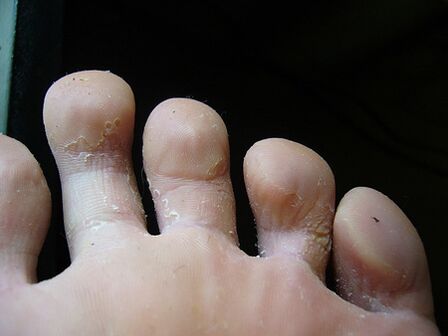
There are a number of dermatological diseases called fungi. The general name for such an infection is "mycoses". If it involves diseases of the skin of the legs, it is called dermatomycosis. If the nail plate is affected, the doctor diagnoses "onychomycosis". This is one of the most common pathologies in humans.
Dermatologists distinguish between different types of fungal infections in humans:
- anthropophiles;
- zooanthropophiles;
- Candida.
The first cause infections in humans, the second – in people and animals, and the third – yeast-like.
Causes of fungal diseases

Fungal spores are found in large quantities in soil, on surfaces and in public areas. We ride home on public transport, go on the swings with our children, buy groceries in the supermarket, work with people in the same room and communicate with pets. Why do some people get sick and others don't?
There are population groups that are more susceptible to fungal diseases than others. Let's take a closer look at them:
- People with reduced immunity.When the body is weakened by surgery or a serious illness, it is less resistant to various infections, including fungal infections.
- Children and the elderly.Both groups are prone to pathologies due to age-related characteristics. A young body is not yet strong enough, and older people already have a variety of chronic diseases that weaken the body.
- People with metabolic diseasescaused by disorders of the thyroid, pancreas, pituitary gland, and circulatory and lymphatic systems.
- Workers in hazardous industries with high temperatures.In such an environment, conditions are created for the development and spread of athlete's foot.
- Lovers of gyms, saunas, swimming pools.In themselves, these activities are very useful, but non-compliance with basic sanitary and hygienic standards when disinfecting these premises leads to the emergence of a problem such as fungal infestation.
Doctors distinguish the following types of fungal diseases of the feet: athlete's foot, trichophytosis and candidiasis. It is believed that men are most often affected by fungus, although this is a controversial statement. They pay less attention to their health, so the disease has progressed.
Main signs of diseases

Visually determining the presence of fungus on the feet is not at all difficult. If you notice redness, your leg begins to itch severely and even painfully, blisters appear that burst, the skin peels off and an unpleasant odor appears, then most likely you have contracted a fungal infection.
This can happen if you step barefoot on sports equipment or the floor of a fitness club, or get an infection from a pet. Finally, there are fungi that are transmitted from animals to their owners. Showering after a shift at a factory can also reward you with this annoyance. Using other people's toiletries - soap, towels, washcloths - is not only unhygienic, but also dangerous.
The disease can begin on the skin and later also affects the nails and the area between the fingers. This is a very serious cosmetic defect. Irregularities form in the nail plate. It will begin to crumble, change color, and possibly disappear altogether. The nail bed becomes inflamed. This is not just a cosmetic defect, but a pathology that causes physical suffering. It even becomes painful for a person to walk.
How to recognize athlete's foot
In order to say exactly what type of dermatomycosis it is, to clarify whether it is really a fungus or calluses, abrasions or corns, a visit to the dermatologist is necessary. To clarify the diagnosis, the doctor carries out a visual examination and prescribes laboratory diagnostics: skin and nail samples are taken. This way you can clarify which type of fungus was detected. Only then will appropriate therapy be prescribed. Each type is treated differently.
You can identify the fungus yourself using potassium permanganate. This is done like this: dilute a weak solution of potassium permanganate. Place the limb in a bowl of solution and observe it. Good, healthy nails become darker, but infected nails remain the same color.
Treatment is usually conservative at home. It consists of the following mandatory points:
- Take medication orallyto destroy fungal spores transmitted through blood and lymph.
- Local treatment.The use of ointments, creams and special liquids to eliminate dermatological manifestations of the fungus. Manipulations are carried out after pedicure and cutting of the affected nails.
- Hygiene and hygiene measures.They consist of disinfecting clothing and shoes. This destroys the spores of the infection.
Fungi are complex, recurrent infections, so therapy must be effective. After a certain period of time, from two weeks to a month, recovery occurs if the recommendations are carefully followed.


















